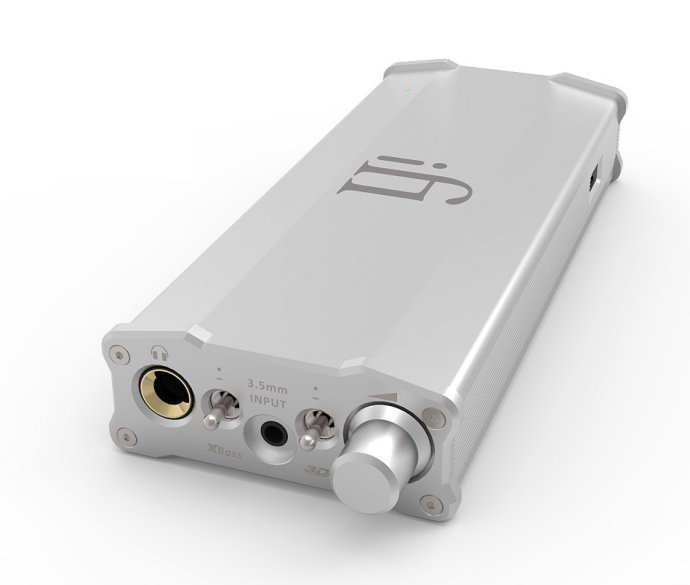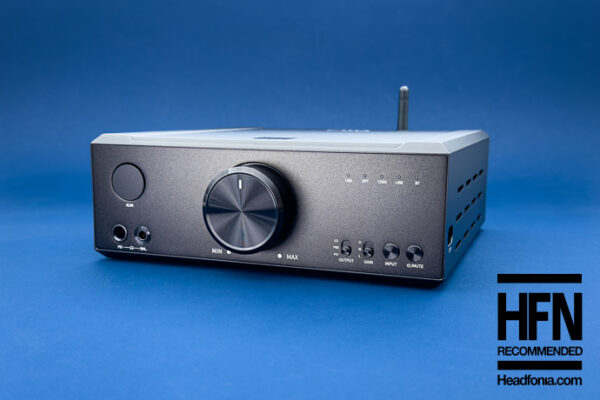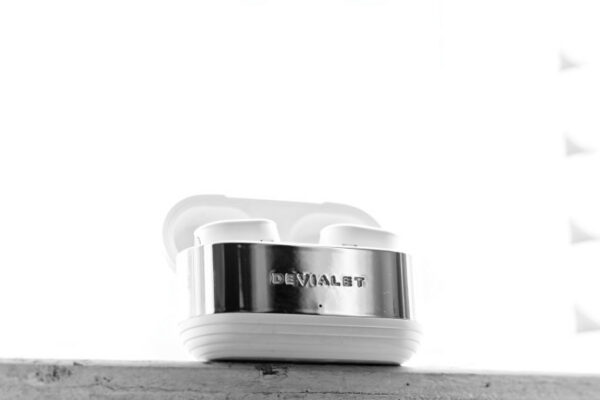Dislcaimer & Editor’s note: After a break, Dave realized he missed writing for Headfonia, and so he’s back to share his views with us all. Welcome back, Dave! If I’m not mistaken he got the IFI iDSD directly from IFI for this review and it will be returned. Do check out my short note at the end of the review (my opinion of the iDSD). A lot of people have been asking about this review, sorry for the delay.
IFI – iDSD
As I welcome myself back to the pages of Headfonia, I do so by bringing IFI Audio with me, as this Micro-iDSD review makes the first time one of their products has graced out pages. I doubt it will be the last. Let’s jump right in and see what the Micro-iDSD is all about.
It seems the iDSD was partially “crowd designed”. Ifi Audio asked people what features they would like to see on their next product. I think that was smart. Why not get a gauge on what your audience would like to see (hear) in their audio gear? The joke here is it looks like the people answered “everything”, because that’s how one would describe all the bells and whistles that come with the iDSD.
These bells and whistles are housed within a very nice silver enclosure. It feels quite solid, and quite resistant to fingerprints. It is a battery powered unit that charges via an included USB cable. Although this COULD be used as a portable DAC and/or AMP, I would put it in the transportable category as opposed to the portable one.
Under the hood lines a dual Burr-Brown chipset handling the DAC function. What chip, it does not say, but what it does say is that it “is the only DAC in the world (at any price) to play True Native Octa-DSD512/PCM768/Double DXD.” Now, I have to admit that my eyes tend to roll and my attention breezes out when I read things like that. Give me a well recorded CD, and you can keep all of your silly other formats. I shouldn’t hold that against IFI Audio, however. Some people like it, and it handles file types that us mortal still use. It’s not like they are charging an extra arm or leg for it. In fact, for the going price of $499, the sound would have to outright stink for this not to be considered a great deal (spoiler: the sound doesn’t suck).
I had a thought, only half joking, about writing two reviews of the Micro-iDSD: one simply covering all the buttons and features of the iDSD, and the other about the sound of the unit. While that might be going a bit too far, there are more than a few buttons to flick on this unit. Let’s start with the front.
From left to right:
- ¼ inch headphone output which does… exactly what you think it does
- on/off switch for their XBass feature which will be discussed later
- 1/8 inch input (yes, an input. So don’t sit there, like I did, with IEMs plugged into it, wondering why no sound is coming out)
- on/off switch for the 3D sound enhancement, again, to be discussed later
- dual purpose volume and power knob, which has just the right amount of pressure to the turn. There is enough so you won’t accidently turn it, but not enough so it is difficult to turn.
There is a lot going on the front here, but it only feels cluttered to me when you have something plugged into the 1/8 input.
Looking at the back, again from left to right:
- SPDIF input/ output. If the iDSD is taking a signal from the USB port, it is an output, if not, it is an input
- RCA analogue output
- USB input
On the right side of the unit:
- USB charging port which will allow you use the iDSD to charge a device with a USB charger. Both my phone, my HM700 and my daughter’s iPad connected and charged without any issue. The only catch is the Micro iDSD has to be turned off for this port to work.
On the left side of the Micro iDSD (back to front)
- Gain switch (eco/normal/turbo)
- Polarity switch
- Analouge filters: standard/minimum phase/bit-perfect for PCM and Extreme/extended/standard range for DSD. The filter for DXD is fixed. Filters will also come up later.
On the bottom (yes bottom!) of the unit, we have:
- Line out/preamp switch which allows you to use the iDSD as either a DAC with a direct line out to another amp, or use it as a preamp and keep the volume pot in play.
- iE match for use with extra sensitive iems. If the eco gain setting is still too loud for your monitors, you can flick this switch to either high-sensitivity or ultra-sensitivity to give yourself even more latitude with the volume pot.
Also listed on the bottom is what all of the switches, inputs and outputs are for. So, should you become forgetful during use as to what is what (not hard giving the preponderance of options), just take a peek at the bottom. Also, a thing to remember is if you want the iDSD to be powered off a USB port, plug the cable into the iDSD and the computer before you turn the unit on. Should you plug it in after, it will run strictly off battery power.
So, this little machine can do my taxes for me, but how does it sound? Find out on Page 2 of this review, right after the click HERE or below.








Kristian Lindecrantz
Welcome back Dave! Great review, and I must say refreshing to not only read overly positive comments on this unit. I’m sure it’s plenty versatile, and has a great set of features, especially for the price. Though maybe it doesn’t mark the second coming of our Lord and saviour as some would have you believe
Headfonia_L.
Yeah, like I mentioned in my Italic part, I’m not the biggest fan. It’s just not my thing. Maybe a bit overhyped but none the less, a decent amp
Dave Ulrich
I is a little on the polite side, but with the right headphones, I still think it sounds quite good. And as for it being the second coming, I did try, and the iDSD can’t turn water into wine.
Headfonia_L.
I’d be interested in such a device 😀
Jeff
Cool! Can you comment on iDSD versus the Hugo please? My friend got an iDSD a few weeks ago and he’s happy with it and I plan to go over to his house to compare it with my Hugo. I am half excited and half worried due to all the positive feedback about the iDSD that I find virtually everywhere.
By the way, in the editor’s note, iDSD is written iDSd. Hope this helps.
Cheers.
Headfonia_L.
What a crappy editor. 🙂
Hugo vs iDSD = Musical delight vs analytic presentation
I’m exagerating a bit, but you’ll hear it for yourself. I would choose the Hugo over the iDSd (see what I did there?) anytime, even if the IFI extracts more detail, it doesn’t present it in the way Hugo does.
Hugo vs ALO CDM, now that’s a different tory…
Jeff
Gah, it’s iFi not IFI… get it right! haha : )
Thanks for giving me an idea of what it may be like. I have listened to the CDM a couple of times already and I did enjoy it but I felt like the HD650 was a better match with the Hugo. I guess other headphones and IEMs may be a different story. Looking forward to part 2!
Cheers.
Yaroslav
HD650. iDSD vs …? Like, something portable or trans-portable, so not Crack. A20? Any other recs? 🙂
Headfonia_L.
Hugo? CDM? CLAS SOLO+DUET? THEOREM?
Yaroslav
Great, thanks! Hugo and CDM are way out of my league, but was thinking Theorem.
Am I right to understand that iDSD, O2 and other “crowd favorites” are no match with HD650 because they are too cold/dry/analytic?
Headfonia_L.
I couldn’t have said it better
Yaroslav
BTW wonder why you didn’t list Concero as an option — just read a wonderful review (right here) and seems it is driven by USB which is just perfect.
Headfonia_L.
it’s not as portable?
Yaroslav
Guess my bad describing requirements than, I am basically upgrading from the Dragonfly so anything USB-powered that can be thrown into a bag is fantastic. And I have HD650s little brother, Momentum, with the iPhone, so no amping really needed there.
Sorry for misleading, I guess.
Alberto Martinez
When you have decided which USB-powered DAC, please let me know. I am in the same process, thanks
Headfonia_L.
Check the Resonessence labs HERUS review. great usb dac and it works on android and iphone via cck
Yaroslav
Oh, while we’re on the point of micro USB DAC/AMP/all-in-one devices, did you have a chance to check Apogee Grove out? Sennheiser partnered with them and with the “constant current drive” thing it stands out from all the others in that category, of course not sure if that is bullshit.
On one hand, Apogee is not exactly known for audiophile stuff (although I had the Duet and its headphone amp was fantastic). On the other, they have the Sennheiser partnership so they are pretty much endorsed..
dalethorn
Someone on Changstar got one and has a happy experience with it. There are no other reviews AFAIK.
Dave Ulrich
The HD650 is much more enjoyable with the iDSD than the O2. It isn’t the best combo with the iDSD, but I wouldn’t call it bad by any means
Yaroslav
Oh, and regarding portables — what about HP-V1 out of a good DAC? Or if we’re going portable, tubes do not matter that much as with full-size and I should not hunt for the likes of that and cheaper ALOs and just get a good SS?
Headfonia_L.
never was fan of that one
James
Comparing features and versatility is like comparing an apple to a suspension bridge. The HUGO is for use with headphones. Period. The IDSd is an all around device that is fantastic on a PC, laptop, etc. I find it funny that many people in the comments here feel the IDSd is over rated but my experience is the opposite. Build quality is another thing. HUGO looks like a piece of cheap junk and I seriously doubt its durability, especially for a mobile centric device.
Gary Webster
This is a great review. As soon as I saw the word ‘meh’ I knew I’d made the right decision in not buying this to partner my Xperia Z3. Thank you for the saving 🙂
Headfonia_L.
Was that my “meh” at the end of the article?
The iDSD is fairly good if you like what it does, it just doesn’t hit my strings
Gary
Yes indeed it was…..although I was about to buy it based on the styling and the drooling head-fiers so a perfectly time intervention if I may say so. A fool and his money….
R12wan
I can definitely see what you mean about being thin and analytical. Borrowed the IDSD Micro and tried it out. Only compared it to listening from the iMac’s headphone port directly and the difference is there. Using Beyer T90. As an example, in the song ‘Royals’ by Lorde, in the first sentence, you can hear that her s’s are thinner and more pronounced. “In the moviesssss” Whereas playing straight form the iMac, her voice is more rounded, a little fuller and to my ears more natural. Same impression playing some Enya. Anyway, I don’t know how helpful this comment will be to others considering this unit but I thought I’d share. To my ears, I found it almost distracting and too analytical. Maybe I’m being too picky!
R12wan
Also, found it a bit problematic using Spotify. For some reason, Spotify had to be already open and then you had to connect via usb. If the unit was already connected and you tried to open up spotify, it wouldn’t open and would crash!
Michael Gunin
In your opinion, how does Micro compare to HRT microStreamer?
Andrew
I have the iDSD and only using it as a DAC into my Schiit Valhalla. The amp in the iFi seemed really noisy to me. I’m a novice and now wonder if a better DSD/MQA DAC will be a better choice. I don’t need the portability I just loved that the DAC had native DSD onboard and I truly thing it does a nice job, but I have nothing to compare it to. The Concero is tempting BUT it’s $850 and does not support MQA. I love DSD files but my bank account doesn’t and the stream from Tidal is indeed impressive for what it is.